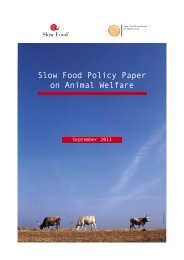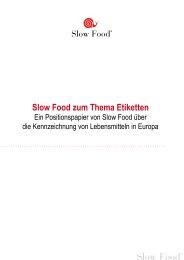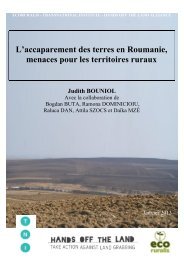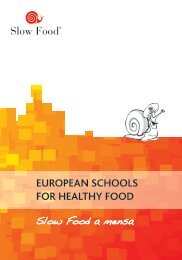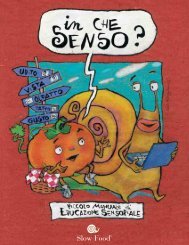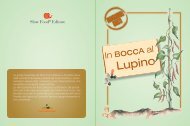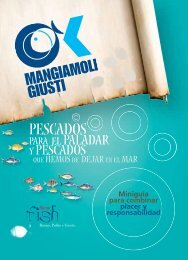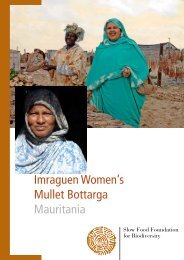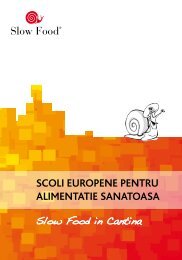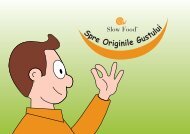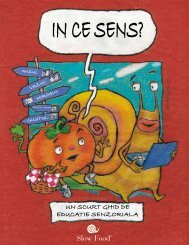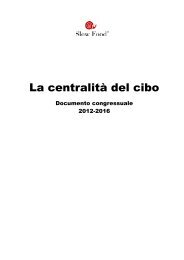English - Slow Food
English - Slow Food
English - Slow Food
Create successful ePaper yourself
Turn your PDF publications into a flip-book with our unique Google optimized e-Paper software.
The <strong>Slow</strong> <strong>Food</strong> approach to food labelling<br />
<strong>Slow</strong> <strong>Food</strong>’s position<br />
on food labelling in Europe
<strong>Slow</strong> <strong>Food</strong> has always emphasized the importance of transparency in food labelling so consumers can be properly<br />
informed on the quality, wholesomeness and traceability of the foods they consume. This enables them to make informed<br />
choices.<br />
<strong>Slow</strong> <strong>Food</strong> welcomes Regulation (EU) n. 1169/2011, which simplifies the law regarding the labelling of food<br />
products, requiring clear, comprehensible and legible labelling (subparagraph 9 of the Preamble). Translated into<br />
the 23 languages of the EU, it will apply to all member states from 13 December 2014, except for the law on nutrition<br />
labelling which will come into force from 13 December 2016. The regulation will apply to all products intended for the final<br />
consumer, including those supplied by mass caterers (restaurants, canteens, catering) and those intended for supply to<br />
mass caterers (Articles 1.3, 8.7). Laws in individual states will therefore have to be modified to take account of the new<br />
provisions.<br />
The Regulation is based on some general objectives. It aims to ensure a high level of protection for the health and<br />
interests of consumers and to promote the free movement of food which has been produced and marketed in accordance<br />
with the law. It firstly specifies a list of mandatory particulars to be included on the label (Article 9).<br />
In addition to the information required in the previous regulations:<br />
• the name of the food, the list of ingredients, net quantity<br />
• the date of minimum durability or the “use by” date<br />
• any special storage conditions<br />
• the name or business name and address of the food business operator responsible for the information given on the<br />
label<br />
• the alcoholic strength of beverages containing more than 1.2 % by volume of alcohol<br />
• instructions for use where it would be difficult to make appropriate use of the food in the absence of such instructions<br />
Regulation 1169 introduces some new requirements. We feel the following are particularly significant:<br />
• The requirement to provide a nutrition declaration. This information gives consumers particulars of energy value and<br />
nutritional value of a food. The label will contain a specified table containing seven items (energy value, amounts of fat,<br />
saturated fatty acid, carbohydrate, protein, sugars and salt). The mandatory nutrition declaration may be supplemented<br />
with an indication of the amounts of one or more of the following: monounsaturated and polyunsaturated fatty acids,<br />
starch, fibre, minerals or vitamins, as defined in Annex XIII of the Regulation.<br />
• The Regulation also addresses the issue of label legibility, noting that this is determined by various elements including<br />
font size, spacing between letters and lines, stroke width, type colour, width-height ratio of the letters, the surface of the<br />
material, and the contrast between the print and the background.<br />
• Article 26 introduces the requirement to indicate the country of origin or place of provenance where failure to<br />
indicate this might mislead the consumer. This requirement is extended to all meat, not only beef as was required<br />
in the previous law, but also sheep, goat, pig and poultry meat (unless the European Commission decides against this<br />
before the deadline for application of the Regulation). The regulation allows for subsequent evaluation regarding the<br />
mandatory indication of the country of origin or place of provenance for other foods such as milk and its derivatives, and<br />
meats used as ingredients in other foods (Article 26).<br />
• Another significant new element in achieving greater transparency is the requirement to specify the type of vegetable<br />
oil used in the list of ingredients (palm oil, peanut oil etc).<br />
• There is a mandatory requirement to indicate potential allergens also in non-prepacked foods such as those sold<br />
at restaurants or in canteens.
The date of minimum durability and the “use by” date<br />
The new regulation has not introduced any changes to the previous law regarding indication of the date of minimum<br />
durability (DMD) or the “Use by” date on food labels.<br />
The provisions of Directive 2000/13/CE therefore remain in force, requiring that, apart from a few exceptions, the DMD<br />
indications for prepacked food labels shall include the wording “Best before”. The date of minimum durability is to be<br />
replaced by the “Use by” date in the case of prepacked foods which, from a microbiological point of view, are highly<br />
perishable and after a short period may constitute a danger to human health. The expiry date must be indicated using<br />
the wording “Use by”.<br />
However there are some new elements as part of European Commission efforts to reduce food waste. The Commission<br />
has launched a series of initiatives to raise consumer awareness about not throwing away food which could still be<br />
consumed.<br />
It is worth noting the recent publication of a report for consumers on the correct interpretation of the wording “Best<br />
before” (indicates the date until which the food retains its specific qualities) and “Use by” (indicates the date until which<br />
the product can be safely consumed).<br />
<strong>Slow</strong> <strong>Food</strong> welcomes consumer education initiatives and greater transparency in the food sector. It hopes that these<br />
issues will have significant coverage in the Communication on Sustainable <strong>Food</strong> scheduled for 2013.<br />
The Regulation allows individual member states to supplement EU law by adopting national measures for specific<br />
types or categories of food (Article 39). They may adopt additional measures that are intended to protect public<br />
health and consumers, prevent fraud and prevent unfair competition, protect industrial and commercial property<br />
rights, indications of provenance, registered designations of origin. Any member state wishing to introduce a<br />
national measure must notify the measure to the Commission and wait for three months before implementing it, provided<br />
that the Commission’s opinion is not negative.<br />
While welcoming the general spirit of the Regulation (EU) n. 1169/2011 and recognizing the significant new provisions<br />
introduced, <strong>Slow</strong> <strong>Food</strong> regrets the lack of more detailed information that can indicate a food’s real quality, enabling<br />
consumers to make more informed choices.<br />
In order to offer consumers more complete and transparent information, <strong>Slow</strong> <strong>Food</strong> launched its narrative label project.<br />
A narrative label does not replace the mandatory label, but supplements it by providing additional information regarding<br />
varieties and breeds, cultivation and processing methods, areas of origin, animal welfare, and advice on storage and<br />
use.
<strong>Slow</strong> <strong>Food</strong> hopes that:<br />
• the European Commission will adopt implementing acts by 13 December 2013 for applying Article 26, regarding the<br />
country of origin or the place of provenance of sheep, goat, pig and poultry meat and that it supports the mandatory<br />
indication of the country of origin or the place of provenance of other products such as milk, other types of meat and<br />
meat used as ingredients.<br />
• member states, as part of their legislative power (Article 39), will strengthen the spirit of the Regulation and adopt<br />
measures to highlight product quality. For this purpose, <strong>Slow</strong> <strong>Food</strong> proposes its narrative label project, in the hope that<br />
member states may find it a useful example.<br />
At the same time <strong>Slow</strong> <strong>Food</strong> will widely publicize its project to European producers, offering practical examples of how<br />
their food products can recover competitive value based on a real authentic difference compared to products which do<br />
not have comprehensive labelling.<br />
What is <strong>Slow</strong> <strong>Food</strong>’s concept of quality?<br />
The communication materials that accompany food products are frequently misleading. They make associations with<br />
bucolic settings and traditional methods, with vague references to old flavours. These evocative portrayals are a long<br />
way from the actual quality of the products being publicized. It is often the small artisan products which suffer. Their<br />
labels are perfectly legal but lack detail: they do not do justice to high quality cheese, biscuits or cured meat and do not<br />
give enough detail about the producer’s background.<br />
Although associations and institutions frequently urge the public to carefully read labels before purchasing, many<br />
consumers are either inattentive when they buy, or if they do seek further information on the label, cannot find sufficient<br />
detail to make an informed choice.<br />
In <strong>Slow</strong> <strong>Food</strong>’s definition, the quality of a food product is first of all a narrative that always starts from its place of origin.<br />
This may be the place where a species was domesticated or diversified; the place where a variety or a breed adapted<br />
or evolved naturally or the place where a cultivation or processing method was developed. It is therefore necessary<br />
to provide information about the characteristics of the environment and local area, processing techniques, storage<br />
methods, marketing, environmental sustainability and, of course, sensory and nutritional properties.<br />
This concept of quality, developed by <strong>Slow</strong> <strong>Food</strong> in the course of twenty years of experience in the field working directly<br />
with thousands of small producers, is one of the aspects that most distinguishes the association from other organizations<br />
working with food and agriculture.
<strong>Slow</strong> <strong>Food</strong>’s narrative label<br />
A narrative label consists of a part which appears on all types of product, with information describing the “local area”<br />
which endows products with specific characteristics. Production localities and their specific soil/climate make a product<br />
distinctive by conferring a particular identity and sensory properties. The label concludes with “Consumer advice” which<br />
gives details about storage and serving suggestions.<br />
A narrative label also contains various other information depending on the food category. For example:<br />
• Labels for vegetable products describe the characteristics of the variety, cultivation methods, types of treatment,<br />
methods of weed control and irrigation. If the products are processed, details are given of the raw materials used and<br />
the production chain.<br />
• Labels for wine highlight aspects which no other form of labelling mentions, such as processing aids, details of vineyard<br />
cultivation and winemaking.<br />
• Labels for cheese describe the animal breeds, types of farming and feed (if forage and feed are produced by the<br />
producer or certified GM free), area of pasture, actual animal welfare due to farming method, processing and ageing<br />
methods.<br />
The <strong>Slow</strong> <strong>Food</strong> Foundation for Biodiversity launched its narrative label project in 2011 and trialled it on a sample of about<br />
70 Presidia products from various countries around the world in 2012. In 2013 it will work with Presidia producers to<br />
create a similar number and will publicize the project among European producers.<br />
Melone<br />
cartucciaru<br />
di Paceco<br />
Caratteristiche della varietà<br />
Di forma ovoidale che termina con una<br />
punta, ha buccia gialla e polpa bianca,<br />
non eccessivamente dolce . È un melone<br />
d’inverno: si raccoglie da settembre all’inizio<br />
di ottobre e si può conservare appeso per un<br />
paio di mesi.<br />
Territorio<br />
Comuni di Trapani e Paceco.<br />
Seme<br />
Locale, conservato e riprodotto dai coltivatori<br />
del Presidio. Si semina da fine marzo ad<br />
aprile.<br />
Coltivazione<br />
Una volta preparato il terreno si semina<br />
direttamente in pieno campo in postarelle<br />
con 15 semi in ciascuna. Dopo la semina,<br />
quando le piante hanno raggiunto<br />
dimensioni adeguate, vengono diradate, per<br />
evitare competizione per lo spazio, l’acqua,<br />
gli elementi nutritivi. Si pratica la rotazione<br />
con grano, aglio o legumi ogni 4 anni.<br />
I produttori ricorrono alla fertilizzazione (con<br />
concime organico: letame di allevatori locali e<br />
minerale: azoto e fosforo, prima della semina)<br />
tenendo conto della tipologia del terreno e<br />
integrando le sostanze nutritive prelevate<br />
dalla pianta. Tale pratica avviene nel periodo<br />
più idoneo, in modo da mantenere o<br />
integrare la fertilità del suolo, evitando inutili<br />
concentrazioni nel terreno e il rilascio di<br />
sostanze inquinanti nelle falde acquifere.<br />
Superficie coltivata<br />
I 4 produttori del Presidio coltivano il melone<br />
cartucciaru su circa 2 ettari e mezzo<br />
Gestione del suolo<br />
Si pratica una lavorazione (aratura) subito<br />
dopo la raccolta di luglio e delle lavorazioni<br />
superficiali per contenere lo sviluppo di erbe<br />
infestanti.<br />
Diserbo<br />
Non praticato.<br />
Trattamenti<br />
Quelli previsti dai regolamenti regionali<br />
dell’agricoltura integrata.<br />
Irrigazione<br />
Non praticata.<br />
Raccolta e post raccolta<br />
Si raccoglie a mano, da settembre a inizio<br />
ottobre, a maturazione non ancora completa.<br />
I meloni sono quindi appesi a maturare in<br />
apposite strutture ben areate per almeno 20<br />
giorni prima della commercializzazione.<br />
Consigli d’uso<br />
Il melone può essere conservato fino a<br />
dicembre-gennaio, appeso in un ambiente<br />
areato. È un ottimo frutto da tavola, e anche<br />
un ingrediente ideale per il gelato e per le<br />
tradizionali granite siciliane.<br />
I Presìdi sono progetti di <strong>Slow</strong> <strong>Food</strong> che tutelano<br />
piccole produzioni di qualità da salvaguardare,<br />
realizzate secondo pratiche tradizionali.
Irrigation Not practiced.<br />
Harvest The garlic is harvested manually<br />
in June and then dried in the shade for<br />
15 days. Following the ancient local<br />
techniques, the stems are braided into<br />
long strings with 12 to 25 heads.<br />
Recommendation for use Keep the<br />
garlic in a cool, dry place, away from<br />
direct light. It can be eaten until the<br />
following spring.<br />
The Presidium involves 12 producers<br />
gathered in the Ljubitovica Šarac<br />
Garlic Producer Association<br />
Caratteristiche della varietà Questo<br />
Allium sativum, luk in croato e cešnjak<br />
in dalmatino, è una varietà serbevole,<br />
sapida, profumata. Le teste sono di<br />
dimensione media, gli spicchi sono<br />
bianchi, con sfumature che vanno dal<br />
rosa al viola.<br />
Territorio Zona di Ljubitovica, nella<br />
regione Spalato-Dalmazia (Croazia), a 18<br />
km dalla costa croata.<br />
Propagazione I bulbilli sono selezionati<br />
e moltiplicati dai coltivatori del Presidio.<br />
L’impianto avviene manualmente dai<br />
primi di ottobre a fine novembre.<br />
Coltivazione I bulbilli sono selezionati<br />
e moltiplicati dai coltivatori del Presidio.<br />
L’impianto avviene manualmente dai primi<br />
di ottobre a fine novembre.<br />
Aglio šarac di Ljubitovica<br />
Prodotto e confezionato da:<br />
Associazione dei produttori di<br />
aglio “Sarac” di Ljubitovica<br />
Ljubitovica 21201 Prgomet<br />
Croazia<br />
Importato per conto di <strong>Slow</strong> <strong>Food</strong><br />
Promozione srl da:<br />
Scambi Sostenibili soc. coop.<br />
Via Sammartino 72<br />
90141 Palermo – Italia<br />
Consumare preferibilmente entro:<br />
04/2013<br />
Lotto: 08/2012<br />
Conservare in luogo fresco e asciutto.<br />
Superficie coltivata I produttori del<br />
Presidio coltivano l’aglio su circa 50 ettari.<br />
Gestione del suolo Lavorazioni superficiali<br />
per contenere lo sviluppo di erbe infestanti.<br />
Diserbo Manuale e meccanico.<br />
Trattamenti Quelli previsti dall’agricoltura<br />
integrata.<br />
Irrigazione Non praticata.<br />
Raccolta Si raccoglie a mano nel mese di<br />
giugno e si fa asciugare all’ombra per circa<br />
15 giorni. I gambi sono intrecciati, secondo<br />
l’antica tecnica locale, in lunghe trecce da<br />
12 o 25 bulbi.<br />
Consigli d’uso Conservare l’aglio in<br />
ambiente fresco e asciutto, lontano<br />
dalla luce. Può essere consumato fino a<br />
primavera.<br />
g<br />
Il Presidio coinvolge 12 produttori<br />
riuniti nell’Associazione Produttori<br />
di Aglio Šarac di Ljubitovica.<br />
Varietal characteristics This variety<br />
of Allium sativum - luk in Croatian and<br />
cešnjak in Dalmatian - is tasty and<br />
aromatic with a long shelf life. The heads<br />
are medium-sized and the cloves are<br />
white with hues from pink to purple.<br />
Production area The area of Ljubitovica<br />
in Split-Dalmatia county (Croatia), 18 km<br />
from the Croatian coastline.<br />
Propagation The bulbils are selected<br />
and multiplied by the Presidium farmers.<br />
They are manually planted from the<br />
beginning of October until the end of<br />
November.<br />
Aglio šarac<br />
di Ljubitovica<br />
Ljubitovica<br />
Šarac Garlic<br />
Cultivation Producers use fertilization<br />
(sheep, goat and chicken manure and<br />
mineral fertilizers) depending on the type<br />
of soil, integrating the nutrients taken<br />
from the plant. Fertilization is carried out<br />
at the optimal time (spring, before sowing<br />
the bulbils), so as to preserve or integrate<br />
the soil fertility and avoid unnecessary<br />
concentrations in the soil or the release of<br />
pollutants in groundwater.<br />
Acreage The Presidium producers grow<br />
their garlic on about 50 hectares.<br />
Soil management The surface is manually<br />
hoed to prevent weeds.<br />
Weeding Manual and mechanical.<br />
Treatments Those allowed by integrated<br />
farming.
Irrigation<br />
Localized drip-irrigation is<br />
placed under the covering. The<br />
strawberry has a large water<br />
requirement, and therefore<br />
irrigation occurs during all stages<br />
of cultivation, at varying rates.<br />
Harvest<br />
The strawberries are harvested<br />
between mid-May and June,<br />
by hand, only after they have<br />
reached full maturity. The job is<br />
carried out with great care, to<br />
avoid harming the fragile fruit.<br />
Recommended Uses<br />
Excellent eaten fresh or used to<br />
prepare sweets and jams.<br />
Presidia are <strong>Slow</strong> <strong>Food</strong> projects that work to<br />
protect small-scale producers and to safeguard<br />
quality, traditional products<br />
Varietal Characteristics<br />
The Tortona strawberry is small to<br />
medium in size, with an intense perfume<br />
and sweet flavor. It is very delicate and is<br />
harvested in the morning and consumed<br />
within 48 hours.<br />
Production area<br />
Municipality of Tortona, at around 200<br />
meters above sea level.<br />
Seeds<br />
Local seeds are reproduced and saved by<br />
Presidium producers. Each year the growers<br />
propagate the runners for planting<br />
between August and September.<br />
www.slowfoodfoundation.com<br />
Cultivation<br />
The strawberry plants are grown directly<br />
in the earth, with the correct proportion of<br />
female and male plants in each plot. Shortly<br />
before maturity, the strawberries are covered<br />
in straw to protect them from the weather.<br />
Producers use fertilizer (chemical fertilizer<br />
applied according to regional regulations<br />
for integrated agriculture before sowing and<br />
during plant growth) taking into account the<br />
soil type and nutrients used by the plant. This<br />
practice takes place during the most suitable<br />
periods, in order to maintain or build soil<br />
fertility and avoid unnecessary concentrations<br />
of fertilizer in the soil and the release of<br />
pollutants into groundwater.<br />
Tortona<br />
Strawberry<br />
Acreage<br />
Around 1,000 square meters.<br />
Diserbo<br />
Manuale.<br />
Soil Management<br />
Surface treatments and covering<br />
with plastic sheeting to contain<br />
weed growth.<br />
Weeding<br />
Manual<br />
Treatments<br />
Those required by regional<br />
regulations for integrated<br />
agriculture.
Document written by: Arianna Marengo<br />
In cooperation with: Raffaella Ponzio, Cristina Agrillo<br />
w w w . s l o w f o o d . c o m<br />
Financed by the European Union.<br />
The sole responsibility of this publication lies with the author.<br />
The European Union is not responsible for any use that may be made of the information contained therein.



